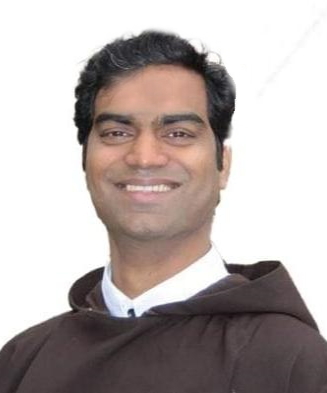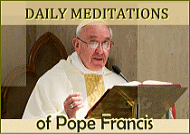The Eucharistic Celebration at Emmaus (Lk 24:13-35)
As is the case often, there are several possible reflections on the gospel text of today. I would like to suggest that Lk 24:13-35 bears resemblance to the Eucharistic liturgy that we celebrate in the Roman Rite.
Allow me to begin with a story, adapted from Margaret Silf’s Wayfarer:
Nicholas had worked for twenty-six years for the same company. Then he was made redundant. By the time his day of departure arrived, most of his immediate colleagues had gone ahead of him into the streets of uncertainty. The smell of redundancy is a bit like the smell of death. No one wants to get too close to it. Perhaps we are afraid that it may be contagious. On his last working day, Nicholas was alone in the office. No one came near. Perhaps no one thought about it, and if they did, they wouldn’t have known what to say. The hours ticked past, and Nicholas’ outer shell was feeling more and more fragile.
Half an hour later, Nicholas left the place where he had worked for half his life. He left by the back door. He left unnoticed and unacknowledged. A Calvary experience. He might well have asked, ‘Where is God in this?’ If this question was in his mind, the next day was going to provide an unexpected answer.
The alarm went off as usual. The habits of a lifetime die hard. Nicholas showered and shaved, and as the truth of his new situation hit him, he felt his legs crumpling up beneath him. It was then that he found himself remembering that since he was eighteen he had never started a working day with nothing to do. The thought turned from ‘I am redundant’ to ‘I am free’. It was a far from joyful turnaround, but it was just a tiny sliver of God getting through a hairline crack in the despondency. He took himself to town to sign on at the Job Centre. After this further experience of humiliation, he happened to bump into one of the homeless people he knew, who populate the town center. The two greeted each other, and Nicholas invited Terence to come to McDonald’s with him for breakfast.
And so the smart, newly redundant executive sat down with the unshaven, inebriated street beggar, over a Big Mac, openly enjoying the discomfiture of the McDonald’s manager and the gradual shuffling away of the other customers to a more distant table. ‘What are you doing here at this time of the day anyway?’ Terence asked him. ‘Shouldn’t you be at work?’ ‘No work,’ Nicholas replied. ‘Just up from the Job Centre. Redundant.’
There was a pregnant pause. ‘Good God,’ retorted Terence, who couldn’t remember the last time he’s slept in a bed. ‘You’re worse off than I am!’ Then he put his arm round Nicholas’ shoulder: ‘I’m so sorry mate,’ he said.
Nicholas remembers that day, and often smiles about it. The day Christ the Consoler met him in McDonald’s in guise of a street beggar, and how he recognized him in the breaking of a burger bun and the pouring of a Coke.
The Structure of the Eucharistic Celebration:
How many parts does the Holy Mass have? The Roman rite of the Eucharistic celebration has four parts:
1. Introductory Rite: from the entrance hymn to the Opening Prayer (which is also called ‘The Collect’).
2. Liturgy of the Word: from the first reading to the bidding prayers.
3. Liturgy of the Eucharist: from the offertory procession till the Prayer after Communion.
4. Concluding Rite: the blessing, dismissal and the concluding hymn.
These four parts of the Eucharistic celebration are recognizable in the gospel passage of today which describes the encounter between Jesus and the two disciples on the road to Emmaus. In a sense, Jesus is celebrating the Mass with them.
1. Introductory Rite – Lk 24:13-24
2. Liturgy of the Word – Lk 24:25-27
3. Liturgy of the Eucharist – Lk 24:28-31
4. Concluding Rite – Lk 24:31-35
In the first part, we see that the two disciples are running away from Jerusalem because they had lost hope in Jesus. They speak about Jesus in the past tense, and their story shows a lot of confusion and discouragement. They had invested three or so good years on Jesus, and apparently everything had come to naught. Jesus joins them in their situation of hopelessness and begins the celebration of the Eucharist. He collects (listens to) their concerns as he walks with them. Jesus builds a close relationship with them, and establishes a context in which to share with them the Word of God.
In the second part – the Liturgy of the Word, Jesus begins to challenge the two men. He uses the Word of God to suggest some deep meaning to the recent events in their lives, that they had not simply wasted their life with Jesus. “Then, starting with Moses and going through all the prophets, he explained to them the passages throughout the scriptures that were about himself” (Lk 24:27). We do not know what method did Jesus use in breaking the Word to them, but surely their hearts were burning within them as they listened to him on the road.
Having established a relationship with the disciples, and having shared the Word of God, now it is time for the Liturgy of the Eucharist. This is the third part of the Eucharistic celebration. Jesus pretends as if to travel on: he gives them an option to see if they would want to go on beyond the Word-heard to the Word-made-flesh! The disciples invite him, “Stay with us, Lord/sir.” So Jesus goes to stay with them. “Now while he was with them at table, he took the bread and said the blessing; then he broke it and handed it to them” (Lk 24:30). These words sound very liturgical; and perhaps they come from the celebration of the Breaking of Bread in the early Christian communities. “And their eyes were opened and they recognized him; but he had vanished from their sight” (Lk 24:30-31).
After recognizing the Risen Lord, the disciples feel empowered. They now want to go back to Jerusalem to share their experience, and to give hope to those who are still waiting to experience Jesus. This is the fourth part of the Eucharistic celebration: the dismissal and mission. “Then they told their story of what had happened on the road and how they had recognized him at the breaking of bread” (Lk 24:35).
The Meaning of the Eucharist in the Light of the Emmaus Encounter:
What was happening to those two disciples as they walked through the different parts of the celebration with Jesus himself; and what should be happening to us as we journey through the different parts of the mass?
· Part 1 – Oh, what is life?
· Part 2 – Yes, life does have meaning.
· Part 3 – Aha, He is alive!
· Part 4 – I want to give hope to others!
1. In the beginning of the mass, may be, we come with our own problems and issues. Perhaps we are frustrated; we are discouraged. We say, “Oh what a life!” We may be feeling like running away from our responsibilities; running away from our faith; running away from our communities. The Introductory Rite of the mass welcomes us, makes us feel at home, invites us to acknowledge our state and feel comforted by the Penitential Rite.
2. In the Liturgy of the Word, we listen to the Word of God. This part of the liturgy helps us find meaning to the events of our lives in the light of the Word of God. The purpose of the Scripture readings or the homily is basically to find meaning to the events of our present life, and to become aware that everything is under the watchful eye of God. At the end of it, we are able to say, “Yes, everything does have a meaning!”
3. To deepen that meaning and to climax it in a God-experience we move on to the Liturgy of the Eucharist. The Liturgy of the Eucharist gives us the possibility of experiencing God in Christ. We experience Him as risen. “He is alive!” He is with us! He has not abandoned me. He gives me hope. This is the core of receiving communion. We get strengthened to continue our lives meaningfully.
4. Finally, having experienced Christ we are now ready to go back to where we came from. May be nothing would have changed in our environment, but since we are empowered by the Word and Sacrament, we want to bring hope to our situations. We are sent as apostles – “Go in the peace of Christ!”
May this Eucharistic celebration, and indeed, every Eucharistic celebration, be an opportunity for us to experience the Risen Lord! May this experience transform us, and thus empower us to transform the world around us.
Fr. Franco Pereira, S.D.B.


